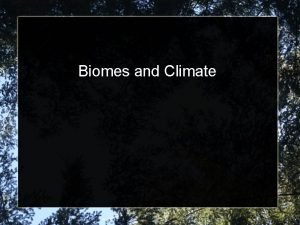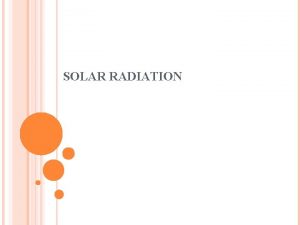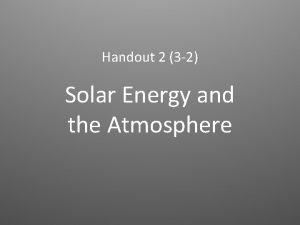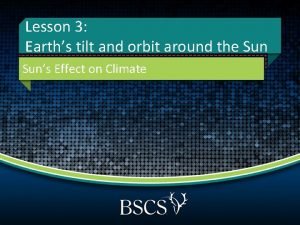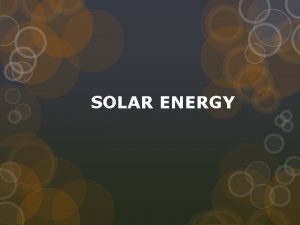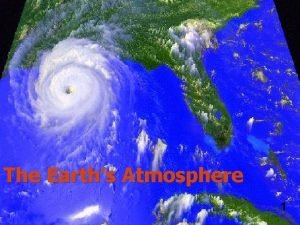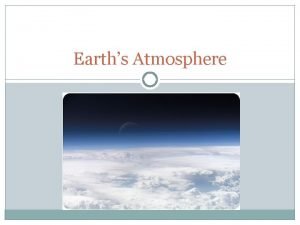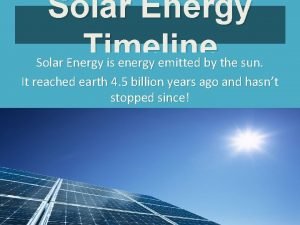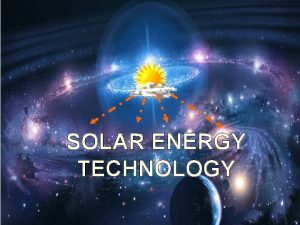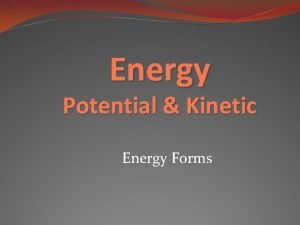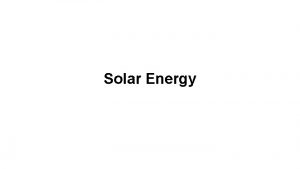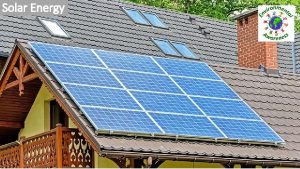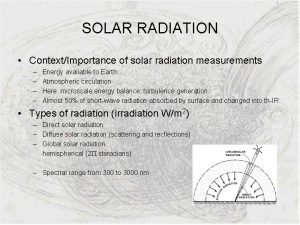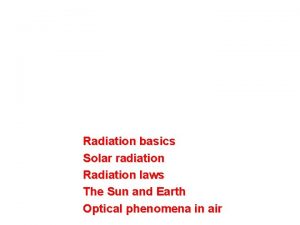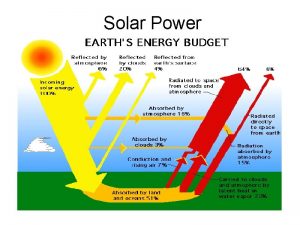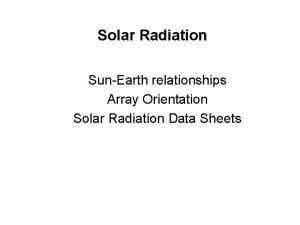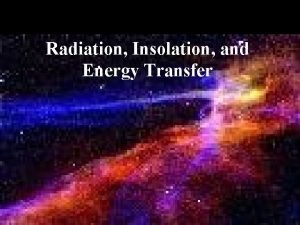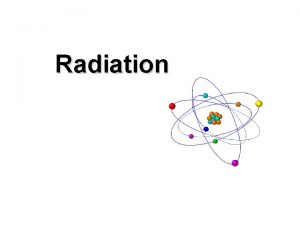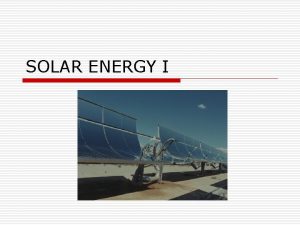Solar Radiation Driving the Earths Weather Energy and

















































- Slides: 49

Solar Radiation Driving the Earth’s Weather

Energy and Power • Energy is defined as “the ability to do work. ” • The standard unit of energy in the International System (SI) is the joule (J). • Power is the rate at which energy is released, transferred, or received. • The unit of power is the watt (W), which corresponds to 1 joule per second – (1 joule = 0. 239 calories).

Forms of Energy • Energy can be grouped into two general categories. • Kinetic energy can be viewed as energy in use. – Often described as the energy of motion. • Potential energy is energy that has not yet been used. – A cloud droplet, for instance, has potential energy due to the position it occupies above Earth’s surface. Like all other objects, the droplet is subject to the effect of gravity. – The higher the droplet’s elevation, the greater its potential energy.

Forms of Energy

Transfer of Energy • Energy can be transferred from one place to another by three processes: conduction, convection, and radiation. • Conduction is the movement of heat through a substance without the movement of molecules in the direction of heat transfer. – Most effective in solid materials – Also an important process in a very thin layer of air near Earth’s surface. – Ex. Transfer of heat from hot stove to hand

Transfer of Energy • Convection is the transfer of heat by the mixing of a fluid. – Accomplished by displacement (movement) of the medium. • During the daytime, heating of Earth’s surface warms a very thin layer of air in contact with the surface. Above this thin laminar layer, air heated from below expands and rises upward because of the inherent buoyancy of warm air (thermals). – Buoyancy is the tendency for a light fluid to float upward when surrounded by a heavier fluid.

Transfer of Energy • Of the three energy transfer mechanisms, radiation is the only one that can be propagated without a transfer medium. • The transfer of energy by radiation can occur through empty space. • Virtually all the energy available on Earth originates from the Sun. • Radiation, however, is emitted by all matter. • Face absorbs radiation on a sunny, summer day and is converted to thermal energy.

Electromagnetic Waves • Electromagnetic Radiation travels in the form of waves • Energy transferred from the sun that releases energy when absorbed by an object. • Radiation can vary. • Measured in micrometers. Wavelength Amplitude

EM Wave Characteristics • The quantity of radiation or energy transported is associated with the height of the wave, or its amplitude. • The distance between wave crests, or wavelength, determines the quality, or “type” of radiation

The Electromagnetic Spectrum

Wavelength Units It is convenient to specify wavelengths using small units called micrometers (or microns). 1 micrometer equals one-millionth of a meter.

EM Wave Characteristics Electromagnetic radiation consists of an electric wave (E) and a magnetic wave (M). As radiation travels, the waves migrate in the direction shown by the pink arrow. The waves in (a) and (b) have the same amplitude, so the radiation intensity is the same. However, (a) has a shorter wavelength, so it is qualitatively different than (b). Depending on the exact wavelengths involved, the radiation in (a) might pass through the atmosphere, whereas that in (b) might be absorbed.

Blackbody Properties • Blackbodies emit the maximum possible radiation at every wavelength. • Earth and the Sun are almost blackbodies. • The single factor that determines how much energy a blackbody radiates is its temperature. • Hotter bodies emit more energy than do cooler ones. • The intensity of energy radiated by a blackbody increases according to the fourth power of its absolute temperature.

Stefan-Boltzmann Law This relationship is represented by the Stefan-Boltzmann law, expressed as: I = σT 4 Where : I is the intensity of radiation in watts per square meter, σ is a constant (5. 67 x 10 -8 watts per square meter) and T is the temperature of the body in kelvins.

Temperature Relationships Celsius Temperature = (o. F - 32) / 1. 8 Fahrenheit Temperature = (1. 8 x o. C) + 32 Kelvin Temperature = o. C + 273

Wien’s Law For any radiating body, the wavelength of peak emission (in micrometers) is given by Wien’s law: max = constant (2900)/T where max refers to the wavelength of energy radiated with greatest intensity. Wien’s law tells us that hotter objects radiate energy at shorter wavelengths than do cooler bodies.

Solar vs Terrestrial Radiation • Solar radiation is most intense in the visible portion of the spectrum. Most of the radiation has wavelengths less than 4 micrometers which we generically refer to as shortwave radiation. • Radiation emanating from Earth’s surface and atmosphere consists mainly of that having wavelengths longer than 4 micrometers. This type of electromagnetic energy is called longwave radiation.

Solar vs Terrestrial Radiation • Applying Wein’s Law – Average Temp Earth = 288 K – Average Temp Sun = 6000 K • Energy radiated by substances occurs over a wide range of wavelengths. • Because of its higher temperature, emission from a unit of area of the Sun (a) is 160, 000 times more intense than that of the same area on Earth (b). • Solar radiation is also composed of shorter wavelengths than that emitted by Earth.

Inverse Square Law • As the distance from the Sun increases, the intensity of the radiation diminishes in proportion to the distance squared. • The solar constant is the amount of solar energy received by a surface perpendicular to the incoming rays at the mean Earth–Sun distance. – This is equal to 1367 W/m 2.

Inverse Square Law

Earth’s Orbit Earth orbits the Sun once every 365 1/4 days as if it were riding along a flat plane. We refer to this imaginary surface as the ecliptic plane and to Earth’s annual trip about the plane as its revolution. Earth is nearest the Sun (perihelion) on or about January 3 (147, 000 km). Earth is farthest from the Sun (aphelion) on or about July 3 (152, 000 km).

Earth’s Tilt and Rotation • Earth also undergoes a spinning motion called rotation. – Rotation occurs every 24 hours around an imaginary line called Earth’s axis, connecting the North and South Poles. – The axis is not perpendicular to the plane of the orbit of Earth around the Sun but is tilted 23. 5° from it. – The axis is always tilted in the same direction and always points to a distant star called Polaris (the North Star).



The latitudinal position of the subsolar point is the solar declination, which can be visualized as the latitude at which the noontime Sun appears directly overhead.

Equinox and Solstice • Summer Solstice (On or about June 21 st) – The Northern Hemisphere has its maximum tilt toward the Sun • Winter Solstice (On or about December 21 st) – The Northern Hemisphere has its minimum availability of solar radiation • Spring and Autumnal Equinox (On or about March 21 st and September 21 st) – On the equinoxes, every place on Earth has 12 hours of day and night – Both hemispheres receive equal amounts of energy.

Why is it colder in the winter if the earth is closer to the sun? Tilt and Solar Altitude • Less Daylight – decrease in amount of solar energy

Beam Spreading • Beam spreading is the increase in the surface area over which radiation is distributed in response to a decrease of solar angle. – The greater the spreading, the less intense is the radiation. – A beam of light is more effective if it has a high angle of incidence.

Absorption of Radiation • Process where radiation is captured by atmospheric gases, particulates, and droplets. • Radiation striking the surface of the particle is converted to heat energy. • This has two effects: – the absorber gains energy and warms – The amount of energy delivered to the surface is reduced.

Atmospheric Absorption

Reflection of Radiation • Radiation making contact with some material is simply redirected away from the surface without being absorbed. • Angle of incident radiation = angle of reflected radiation. • Albedo = reflected radiation / incident radiation. • When light strikes a mirror, it is reflected back as a beam of equal intensity, in a manner known as specular reflection.

Atmospheric Scattering • Radiation is reflected from an object as a large number of weaker rays traveling in different directions. • Scattering can be from large solid surfaces, gas molecules, particulates, and small droplets. • Scattering is wavelength dependent. • Radiation is scattered both back to space and toward the surface. • Scattered energy reaching Earth’s surface is thus diffuse radiation, which is in contrast to unscattered direct radiation.

Rayleigh Scattering • Scattering agents – Less then one-tenth wavelength of incoming radiation • Most effective for those colors with the shortest wavelengths.

Mie Scattering • Scattering by aerosol particles considerably larger than air molecules • Tendency to scatter longer wavelengths then Rayleigh scattering does. • Air pollution can enhance affect.

The sky appears blue because gases and particles in the atmosphere scatter some of the incoming solar radiation in all directions. Air molecules scatter shorter wavelengths most effectively. Thus, we perceive blue light, the shortest wavelength of the visible portion of the spectrum.

Sunrises and sunsets appear red because sunlight travels a longer path through the atmosphere. This causes a high amount of scattering to remove shorter wavelengths from the incoming beam radiation. The result is sunlight consisting almost entirely of longer (e. g. , red) wavelengths.

Nonselective Scattering • The water droplets in clouds are considerably larger than suspended particulates • All wavelengths of incoming radiation are scattered about equally

Solar radiation and the earth’s surface • The fraction of solar radiation that does make it to the earth’s surface is either reflected or absorbed (increasing the surface’s temperature) – Common Albedos • Urban area: 14 -18 – daytime highs warmer during sunny days • Cirrus clouds: 40 -50 – keeps nighttime temperatures warmer – daytime cooler • Fresh snow: 75 -95 – daytime temps cooler

The Balancing Act


Sensible Heat • When energy is added to a substance, an increase in temperature occurs that we physically sense. • This is called (sensible heat). • The magnitude of temperature increase is related to two factors: – Specific heat, which is defined as the amount of energy needed to produce a given temperature change per unit mass of the substance. – The temperature increase resulting from a surplus of energy receipt also depends on the mass of a substance.

Latent Heat • Latent heat is the energy required to change the phase of a substance (solid, liquid, or gas). • In meteorology we are concerned with the heat involved in the phase changes of water. – In the case of melting ice, the energy is called the latent heat of fusion. – For the change of phase from liquid to gas, the energy is called the latent heat of evaporation.

The Greenhouse Effect • Absorption by atmospheric gasses varies greatly by wavelength – Some wavelengths are strongly absorbed, while other wavelengths have little or no absorption. • Greenhouse gasses are very transparent to solar radiation, but absorb infrared radiation (emitted by the earth) very well. – These gasses in turn heat, and emit infrared radiation back toward the surface = Greenhouse effect • Global radiative equilibrium keeps the planet’s temperature in check – emission of heat to space in the form of infrared radiation balances the solar radiation’s heating – this equilibrium can be disturbed…

Infrared Response and the Greenhouse Effect • Principle greenhouse gasses: – Water vapor – evaporated water – example=DESERT DAILY TEMPERATURE VARIATION – Carbon dioxide – respiration, burning fossil fuels – Methane – decomposition, cows – Nitrous oxide – Ozone…

Greenhouse Warming Examples • The Gulf Coast and desert Southwest – Similar solar radiation and daytime highs, but different morning lows – why? – Reason: amount of water vapor – More water vapor exists near gulf coast and it traps IR radiation leaving the surface. Drier air in the southwest does not trap radiation allowing temperatures to drop • Clouds – generally composed of water droplets – Cloudy nights are warmer – trap IR radiation – Cloudy days are cooler – block solar radiation

The Stratospheric Ozone Shield • Ozone (O 3) – 3 oxygen atoms – relatively unstable • Near the surface – ozone is a air pollutant, and a major contributor photochemical smog (Chapter 2) • Ozone in the stratosphere shields us from lethal intensities of Ultraviolet (UV) radiation – great absorber at UV wavelengths.

One of the most immediate and obvious outcomes of radiation gain or loss is a change in the air temperature. The map depicts differences between mean temperatures in January and July through the use of isotherms, which are lines that connect points of equal temperature.

Other Influencing Factors Certain geographical factors combine to influence temperature patterns across the globe. These factors include latitude, altitude, atmospheric circulation patterns, local conditions, continentality, (the effect of an inland location that favors greater temperature extremes) and ocean current characteristics along coastal locations.

~ Earth’s weather is the result of the atmosphere’s response to the horizontal and vertical transport of heat and moisture ~
 Solar energy is free. solar is inexhaustible
Solar energy is free. solar is inexhaustible Wind energy is actually an indirect form of
Wind energy is actually an indirect form of Solar radiation has a part in the water cycle by
Solar radiation has a part in the water cycle by National solar radiation database
National solar radiation database Average weather conditions over time
Average weather conditions over time Solar radiation
Solar radiation Solar radiation
Solar radiation Wholesale solar power
Wholesale solar power Energy energy transfer and general energy analysis
Energy energy transfer and general energy analysis Energy energy transfer and general energy analysis
Energy energy transfer and general energy analysis Earth layers foldable
Earth layers foldable Earths roation
Earths roation Whats a natural satellite
Whats a natural satellite Biome near the equator
Biome near the equator Periodic table of elements families
Periodic table of elements families How thick is the earths crust
How thick is the earths crust Whats earths moon called
Whats earths moon called Whats the thickest layer of the earth
Whats the thickest layer of the earth Earths early atmosphere contained
Earths early atmosphere contained Which layers together constitute the lithosphere?
Which layers together constitute the lithosphere? Earths major crustal plates
Earths major crustal plates Earths orbit seasons
Earths orbit seasons Brown earth soil ireland
Brown earth soil ireland Earths physical features
Earths physical features Honey fertilizer
Honey fertilizer What is luna moon
What is luna moon Continental drift theory
Continental drift theory Earths crust
Earths crust Where
Where What does the earths tilt cause
What does the earths tilt cause Earth's atmosphere description
Earth's atmosphere description What is the true shape of earth
What is the true shape of earth Earths kayers
Earths kayers What does earths tilt do
What does earths tilt do Earths boundaries
Earths boundaries 4 spheres of the earth
4 spheres of the earth Weather model symbols
Weather model symbols Whether the weather poem
Whether the weather poem Her poem clothes
Her poem clothes Sunny rainy cloudy stormy
Sunny rainy cloudy stormy Whether the weather is fine
Whether the weather is fine Heavy weather by weather report
Heavy weather by weather report Capital weather gang weather wall
Capital weather gang weather wall Solar energy is radiant light and heat from the sun
Solar energy is radiant light and heat from the sun Solar energy and the atmosphere
Solar energy and the atmosphere Why do thermal inversion layers trap pollutants
Why do thermal inversion layers trap pollutants Timeline of solar energy
Timeline of solar energy Solar irradiation
Solar irradiation What is electrical energy
What is electrical energy Avi solar energy pvt ltd
Avi solar energy pvt ltd




